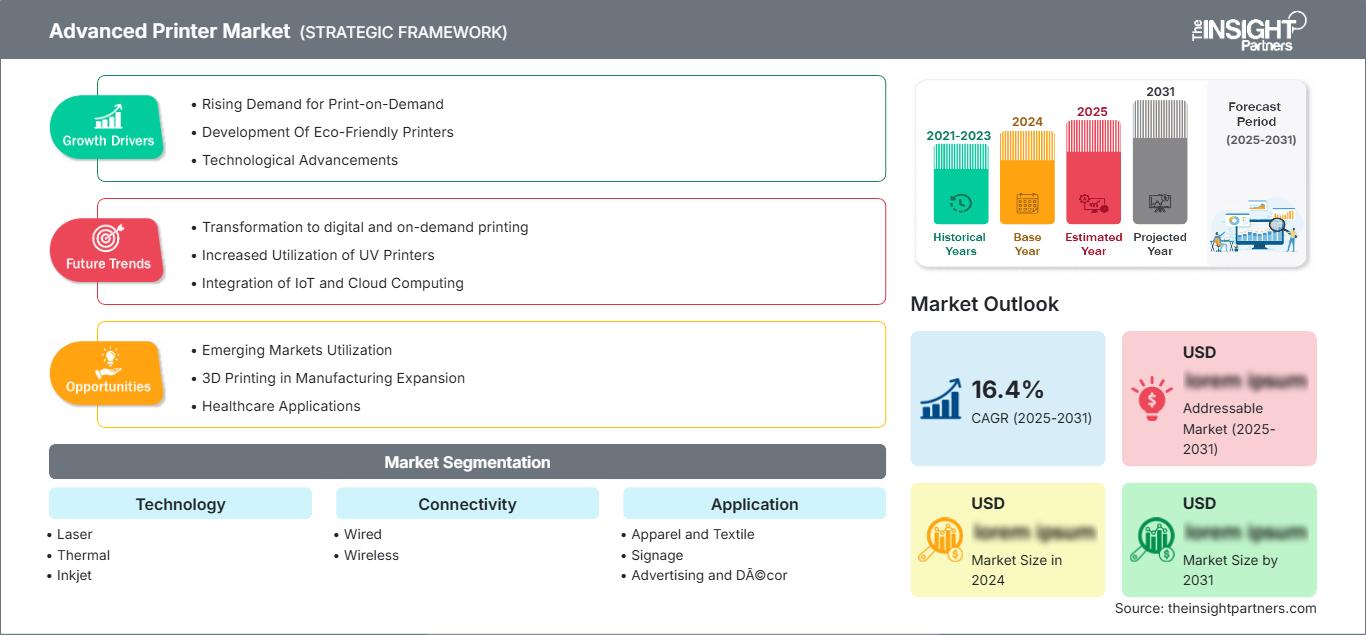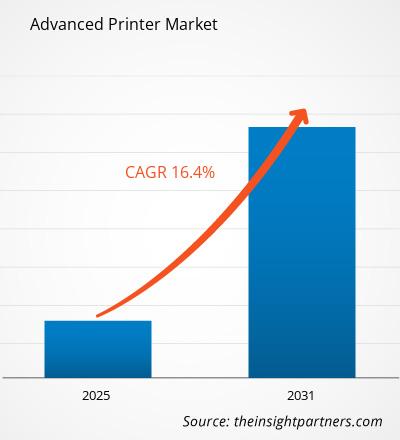预计高级打印机市场在 2025 年至 2031 年期间的复合年增长率将达到 16.4%,市场规模将从 2024 年的 XX 百万美元扩大到 2031 年的 XX 百万美元。
高级打印机市场研究报告研究了影响增长的主要趋势,从对高质量打印日益增长的需求到快速发展的 3D 打印技术。该报告按技术(激光、热敏、喷墨、点阵、其他)、连接(有线、无线)和应用(服装和纺织品、标牌、广告、装饰、办公和专业、CAD 和技术印刷、商业和出版物、其他)细分,然后是最终用户行业(工业、商业、住宅)。全球分析按区域和主要国家细分。上述细分分析中的市场评估以美元表示。
报告目的
Insight Partners 发布的《高级打印机市场》报告旨在描述当前形势和未来增长、主要驱动因素、挑战和机遇。这将为各业务利益相关者提供见解,例如:
- 技术提供商/制造商:了解不断变化的市场动态并掌握潜在的增长机会,使他们能够做出明智的战略决策。
- 投资者:对市场增长率、市场财务预测以及整个价值链中存在的机会进行全面的趋势分析。
- 监管机构:规范市场政策和警察活动,以最大程度地减少滥用,维护投资者的信任和信心,并维护市场的完整性和稳定性。
高级打印机市场细分技术
- 激光
- 热敏
- 喷墨
- 点阵
- 其他
连接
- 有线
- 无线
应用
- 服装和纺织品
- 标牌
- 广告和装饰
- 办公和专业
- CAD 和技术打印
- 商业和出版物
- 其他
最终用户行业
- 工业
- 商业
- 住宅
您将免费获得任何报告的定制,包括本报告的部分内容,或国家级分析、Excel 数据包,以及为初创企业和大学提供超值优惠和折扣
先进打印机市场: 战略洞察

- 获取本报告的主要市场趋势。这个免费样本将包括数据分析,从市场趋势到估计和预测。
先进打印机市场的增长动力
- 按需印刷需求不断增长:包装、纺织品和广告印刷的定制化需求很高——他们需要高质量的个性化印刷品。这种定制化和按需印刷需求推动了各个领域对尖端打印机的需求。
- 环保型打印机的发展:可持续发展的推动带来了化学品使用量更少、能耗更低的绿色打印机。此外,还有一种趋势是,打印机使用可生物降解、可持续且环保的产品进行打印,企业和客户都可以购买。
- 技术进步:3D打印、喷墨打印机和激光打印机等印刷技术的创新,为市场的增长做出了重大贡献。这些进步使得打印解决方案更快、更高效、更具成本效益,可满足医疗保健、汽车和教育等各个行业的需求。
高级打印机市场未来趋势
- 向数字和按需打印转型:纸质打印正逐渐被数字打印所取代,数字打印具有更快的周转时间、灵活性和更低的价格。企业正在采用按需打印,这消除了浪费并缩短了打印周期,并推动了数字化转型。
- UV 打印机利用率提高:UV(紫外线)打印机的需求正在增长,因为它们几乎可以在任何类型的材料上打印,包括塑料、木材、玻璃和金属。这种类型主要用于广告、包装和装饰等商业印刷,这些印刷需要多功能的打印设备。
- 物联网和云计算的集成:物联网和云计算与打印机的使用相结合是一个强劲的趋势。支持物联网的打印机使公司能够远程集中监控和管理其打印机,从而优化工作流程、提高生产力并增强安全性;这些也是云打印在分布式操作中的流行应用。
高级打印机市场机遇
- 新兴市场利用:亚太、非洲和拉丁美洲新兴市场的城市化和工业化正在为高级打印机开辟新的市场。这些不断增长的市场需要高质量且经济高效的打印解决方案,适用于从包装、纺织到广告等各个领域。
- 3D 打印在制造业的扩展:3D 打印正在创造新的制造、原型设计和产品制造可能性。汽车、航空航天和医疗保健行业正在寻求高端打印机来构建原型、零件和医疗器械,这开辟了一个有利可图的机会。
- 医疗保健应用:先进的打印技术,尤其是 3D 打印技术,正在医疗保健领域迅速应用,涵盖从假肢和植入物到组织和器官的生物打印等各个领域。该领域的增长将比其他领域更快。
高级打印机市场
The Insight Partners 的分析师已详尽阐述了预测期内影响高级打印机市场的区域趋势和因素。本节还讨论了北美、欧洲、亚太地区、中东和非洲以及南美和中美洲的高级打印机市场细分和地域分布。
高级打印机市场报告范围
| 报告属性 | 细节 |
|---|---|
| 市场规模 2024 | US$ XX million |
| 市场规模 2031 | US$ XX Million |
| 全球复合年增长率 (2025 - 2031) | 16.4% |
| 历史数据 | 2021-2023 |
| 预测期 | 2025-2031 |
| 涵盖的领域 |
By 技术
|
| 覆盖地区和国家 | 北美
|
| 市场领导者和主要公司简介 |
|
高级打印机市场参与者密度:了解其对业务动态的影响
高端打印机市场正在快速增长,这得益于终端用户需求的不断增长,而这些需求的驱动因素包括消费者偏好的不断变化、技术进步以及对产品优势的认知度不断提高。随着需求的增长,企业正在扩展其产品线,不断创新以满足消费者需求,并抓住新兴趋势,从而进一步推动市场增长。

- 获取 先进打印机市场 主要参与者概述
主要卖点
- 全面覆盖:该报告全面涵盖了对高级打印机市场的产品、服务、类型和最终用户的分析,提供了整体格局。
- 专家分析:该报告基于对行业专家和分析师的深入了解而编写。
- 最新信息:由于该报告涵盖了最新信息和数据趋势,因此确保了业务相关性。
- 定制选项:此报告可以根据特定客户要求进行定制,并恰如其分地适应业务策略。
因此,有关高级打印机市场的研究报告可以帮助引领解码和理解行业情景和增长前景的线索。尽管可能存在一些合理的担忧,但本报告的总体优势往往大于劣势。
- 历史分析(2 年)、基准年、预测(7 年)及复合年增长率
- PEST和SWOT分析
- 市场规模、价值/数量 - 全球、区域、国家
- 行业和竞争格局
- Excel 数据集
近期报告
客户评价
购买理由
- 明智的决策
- 了解市场动态
- 竞争分析
- 客户洞察
- 市场预测
- 风险规避
- 战略规划
- 投资论证
- 识别新兴市场
- 优化营销策略
- 提升运营效率
- 顺应监管趋势




















 获取免费样品 - 先进打印机市场
获取免费样品 - 先进打印机市场